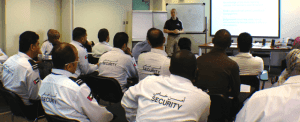During a trip to the middle east back in 2010 to visit with a number of psychiatric institutions and hospitals to give advice and training, I recall being shown the ‘restraint chair’ in the picture at one of the units I visited. I remember being quite surprised at the sight. Even though I was aware of the use of such devices in the USA in corrections and psychiatric settings, I hadn’t at that time been up close to one and I recall a distinct feeling of unease about it.
One of our client hospitals in the middle east regularly receives people with mental illness who are brought to the hospital by their relatives, already shackled with chains around their ankles. When the nurses ask for the chains to be removed, the families often refuse. In fact, when they register their loved-one for care, the family often insist that the shackles be used at all times with their confused and ill family member. They don’t see anything wrong or abusive about the shackles – it is just what they do to stop their loved one from running off and hurting themselves or someone else.
Recently, at the annual NFPS use of force seminar, I listened with interest to Eric Baskind – an expert on use of force issues – as he talked about the comparatively unique approach to physical restraint we have here in the UK. Our healthcare institutions mostly decry the use of devices and instead generally view the ‘manual’ option of physical restraint by hand as being a more humane and ethical approach. Perhaps this attitude is a hangover from the ‘bad old days’ in the asylums where chaining people to the wall was seen as an appropriate intervention for very ill patients
One interesting thing about Mr. Baskind’s contribution at the seminar was that, when we look around at other countries in the world, there appears to be much less physical restraint going on. So, what is the difference? It hardly stands to reason that violent behaviour might be utterly different across national or political borders in hospital settings. My own experience of training in the USA and in the UK and across the middle east would seem to suggest that violence is an issue in almost every emergency department and psychiatric department in the world, so what are they doing? The difference seems to be that in most other countries, potentially violent patients are medicated more quickly and more frequently to control their behaviour.
So, in regard to the best or most humane, or most effective, or safest approach to restraint, some say tomah-to, some say tomay-to!
Whether you’re looking a chair with straps, or heavy medication or shackles, one piece of advice from my conflict/verbalisation skills mentor at Vistelar, Gary Klugiewicz, rings clear to me:
“We may not want to use these interventions, but they may become necessary in some environments or circumstances – it depends. What I can guarantee you is that we are going to try very hard NOT to need to use them at all. BUT IF the subject DOES need to have that measure applied to them, I can also guarantee you that we will get them OUT of that intervention as quickly as is possible – all by using professional verbalisation skills.”
The point here is this: whatever your attitudes to the methods and types of restraint which might be applied to someone, one of the key issues is how much the professionals around the subject of the intervention are trying to make that act an absolute last resort and how they are planning to create an environment which is safe before, during and afterwards.
For more about the potential logic and safety of restraint devices, read my exploration of the Soft Restraint System in a previous blog post.
———————————————-

Gerard O’Dea is a conflict management, personal safety and physical interventions training consultant. He is the training director for Dynamis, a specialist in personal safety and violence reduction initiatives and the European Adviser for ‘Verbal Defense and Influence’, a global programme which addresses the spectrum of human conflict. www.dynamis.training


